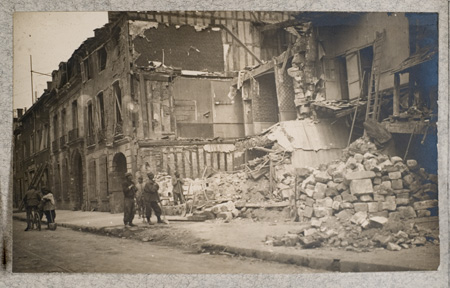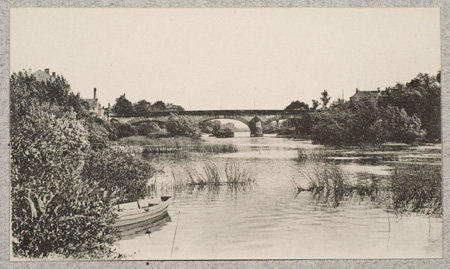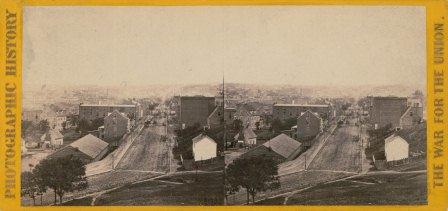By Dan Hinchen, Reader Services
Each summer for the last ten years I have been fortunate enough to call Cape Cod home, specifically, the town of Brewster. As someone who travels to the Cape as a summer employee, I have occupied a position of not-quite-a-local but also not a tourist. Over the past three years, as my full-time employment on the Cape morphed to part-time labor (coincidental with my employment at the Historical Society) I have become much more familiar with the tourists’ view of things as I repeatedly travel the road from Boston to Brewster.
The roughly 90-minute drive from South Boston to Brewster that I repeat each week consists of three main phases: exiting the city on I-93, merging onto Rt. 3, and then crossing the Cape Cod Canal and cruising on Rt. 6. The elevated road out of Boston, I-93, gives drivers glimpses of Boston Harbor to the east and Dorchester and the Blue Hills to the west. After about 10 miles, drivers merge onto Route 3 which carries travelers through many towns of the South Shore between Quincy/Braintree and Plymouth. As a Boston-Cape Cod commuter I am familiar with the names of these towns as their signs pass by – Norwell, Hanover, Duxbury, Pembroke – but I rarely see the towns themselves. Instead, this section lends little to the eye except two lanes of highway and ubiquitous scrub pines for about 45 miles. Then, things change suddenly but briefly as the Cape Cod Canal appears. At the apex of the Sagamore Bridge the driver (or better, the passenger) is afforded a view west-southwest along the canal and, to the east-northeast, a view of Cape Cod Bay expanding to the horizon. However, this vista is fleeting and soon the driver returns to a road that is not that dissimilar from the many miles just traveled. Now it is a matter of time before the highway is left behind and the destination reached.
Traveling to Cape Cod was not always this way. For one thing, the modes of transportation have changed. According to an account of a trip to Cape Cod on 29 Aug 1827, Thomas Wren Ward (1786-1858) “left Boston at half past Seven in a carryall with two horses, our own (Blackfoot) and one of Mr. Groggs, (the miller,) and proceeded over the Neck through Dorchester on our way to Sandwich.” But with no highway to breeze by every town between here and there, Mr. Wren provides several comments relating to the character and people of these towns:
Hingham a very neat & beautiful village – no people seen in the streets – every one about his business. The people of Hingham close, calculating, & very economical – habits good – & a town thriving…Great place for eggs.
From Scituate you pass over part of Hanover, Pembroke, Kingston to Plymouth, about 20 miles. A good house at Pembroke 10 miles from Plymouth…Pembroke and Kingston, the latter especially, very pretty towns.
Great appearance of neatness and industry in all the towns on the So. Shore. At Plymouth, Mrs. Nicholson’s—good tavern—near the court house.
Ward’s fairly brief account gives some insight into the character of the people and places of the South Shore and through comparison we can see what has changed.
Trout in the Small brooks on the road across to Buzzard’s Bay, which is six miles from Sandwich. Oysters plenty across the neck of land; this is the place where the Canal was talked of.
And though he does not provide specific time sets for his journey, in reading the entire text it becomes clear that this trip probably took at least a couple of days:
[Mr. Elisha] Pope has a store – obliging man – very civil to us. The taverns full. Met Mr. Goodwin, who carried us to Mrs Newcombe’s who was persuaded to take us in.
Moving ahead just 20 years, Sarah Augusta Mayo (1830-1886), a Brewster native, relates a story of traveling in the opposite direction and, despite advances in travel, the reader gets some idea of what an undertaking it was to move from Brewster to Boston. In the published edition of her diary, Ms. Mayo records some details about her journey:
The stage driver called for us at four o’clock before which we had our breakfast by lamp light. This was the first time I had been to Boston by land. We went by Higgins’ stage line to Yarmouth Port where we changed at Sears’ hotel for Boyden’s coach to Sandwich. Plymouth was the nearest railroad point to Cape Cod at this time.
We stopped at Pope’s hotel in Sandwich, where we took a third stage coach for Plymouth. This was a long drive. We took our dinner at a forlorn place in the woods called Cornish’s tavern. Soon after our arrival at Plymouth we took a train at 3 P.M. for Boston and reached Chelsea at 7 in the evening…
Then, as now, the land route was not the only option for people making the trip from Boston to Brewster. As Ms. Mayo notes in her writing, “On the 15th of July 1850 I left Brewster on the steamer Naushon arriving at Boston at 3 o’clock P.M.” We do not know when she boarded the vessel but, given her arrival time, it can be fairly assumed that this route did not take as long as the overland track.
With the re-introduction of rail service from Boston to Cape Cod, travelers once again have three primary options for making the trip: boat, rail, and, personal conveyances (substituting cars for carryalls). And yet, it is not so hard to imagine that there might be a day when traveling to Brewster in highway traffic takes quite as long as Ms. Mayo’s journey via stage and rail. Which would you prefer?




